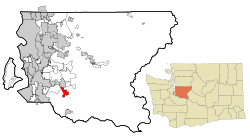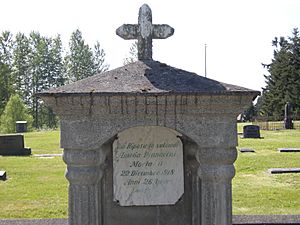Black Diamond, Washington facts for kids
Quick facts for kids
Black Diamond, Washington
|
|
|---|---|

Top Works at Mine 11, Black Diamond, ca. 1915.
|
|

Location of Black Diamond, Washington
|
|
| Country | United States |
| State | Washington |
| County | King |
| Established | mid-1880s |
| Incorporated | February 19, 1959 |
| Government | |
| • Type | Mayor–council |
| Area | |
| • Total | 7.19 sq mi (18.65 km2) |
| • Land | 6.60 sq mi (17.09 km2) |
| • Water | 0.60 sq mi (1.54 km2) |
| Elevation | 653 ft (199 m) |
| Population
(2020)
|
|
| • Total | 4,697 |
| • Estimate
(2023)
|
6,602 |
| • Density | 1,000.51/sq mi (386.29/km2) |
| Time zone | UTC–8 (Pacific (PST)) |
| • Summer (DST) | UTC–7 (PDT) |
| ZIP Code |
98010
|
| Area code(s) | 360 and 564 |
| FIPS code | 53-06330 |
| GNIS feature ID | 1516603 |
Black Diamond is a city in King County, Washington, United States. The population was 4,697 at the 2020 census. In 2023, with a 40.6% growth rate, Black Diamond was the fastest growing small city in King County.
Contents
History
Founding
Black Diamond was originally inhabited by the Bəqəlšuł, which is Lushootseed for "from a high point from which you can see", part of Coast Salish people. The area was home to a grill trap and smokehouse, and the tribe fished from Lake Sawyer.
Black Diamond was officially incorporated on February 19, 1959. The town's late 20th century population growth has been mostly as a commuter community for people with jobs in Seattle, Bellevue, and suburban centers within the Seattle Metropolitan Area.
Coal mining
Beginning in the 1880s Black Diamond was a rural coal mining area, developed by the Black Diamond Coal Mining Company of California, which owned and operated the mine. The original residents were largely composed of former workers, from the company's previous coal mining operation in Nortonville, California, which primarily sold coal to the thriving new metropolis of San Francisco. A combination of low quality coal from the Nortonville mines, water intrusion into the workings there, and the discovery and economical transport of higher-quality Washington coal to San Francisco spelled the demise of Nortonville in the early 1880s. The town was home to around 3,500 people by the early 1900s, many of them European immigrants; most of the working men were involved in producing coal. This coal was transported to Seattle via the Pacific Coast Coal train. Before 1911, the miners were affiliated with the United Mine Workers of America (UMWA), but by March 1911 had left en masse to join the Industrial Workers of the World (IWW).
After World War I, the town shut down the mine as it was no longer viable. A second mining boom spurred growth in the town in the early 1930s on the strength of multiple mining operations promoted by the Morris brothers through the Palmer Coking Coal Company. Mining has continued until recently through the Pacific Coast Coal Company, formerly of San Francisco. The prospect of future mining operations remains strong.
The main building of the Black Diamond Historical Museum is the former train station, which served the Columbia & Puget Sound Railway 1884–1916 and the Pacific Coast Railway 1916–1951. Regular passenger service ended in 1925, but a train still brought men to the mine until 1931, and trains continued to haul coal and freight into the 1940s.
Planned growth via master planned developments (MPDs)
In the 1990's, the first Black Diamond city planner (Jason Paulsen), seized an opportunity to create a comprehensive development plan for the City of Black Diamond that when completed, would fundamentally change what and how the City of Black Diamond would evolve into — the first set of plans being the Growth Management Act (GMA) Comprehensive Plan, which included the concept of Master Planned Developments (MPDs).
In 2008 156 acres (63 ha) were purchased for the first MPD. In 2010 the first MPDs applications were filed with the City of Black Diamond.
Legal action against first MPDs
From 2010 through 2018 legal battles were fought delaying development of the first MPDs:
- In 2010 Toward Responsible Development filed a land use petition (LUPA) against the first two MPDs.
- In 2012 King County Superior Court denied the LUPA Toward Responsible Development filed with the Court of Appeals.
- In 2014 appeals Court Commissioner Masako Kanazawa ordered Toward Responsible Development to pay a total of $162,798, for attorney fees and costs, to YarrowBay and the City of Black Diamond.
- In 2016 Oakpointe (formerly YarrowBay) sued three City of Black Diamond Council members who opposed the MPDs.
- In 2017 Black Diamond council files suit against the mayor.
- In 2018 Black Diamond / Oakpointe settle lawsuit.
First MPDs
The first two MPDs comprised 6,050 single and multi-family residences, 1.1 million square feet of commercial/office/retail space and were estimated to 15,000 new residents to the City of Black Diamond; which would increase the population of the city by 3.6 times its size at the time (2010 population estimate of 4,151).
In December 2013 development started on the first MPD; known as Ten Trails. In 2019 the first family moves into Ten Trails.
In 2021, with a 21% growth rate, Black Diamond was the fastest growing small city in King County.
In March 2022, 845 households were occupied in Ten Trails (722 residential homes, 76 apartment units, and 47 rental homes).
Using King County's 2020 Person's per household rate of 2.43, 845 households being occupied in Ten Trails in March 2022, the estimated population of Black Diamond in 2022 being 6,336, concludes the estimated population living in Ten Trails in March 2022 being 2,053 (845 * 2.43); which roughly equates to 79% ( 2,053 / 6,336) of the population of Black Diamond living in the first MPD (Ten Trails) during March 2022.
Geography
According to the United States Census Bureau, the city has a total area of 7.193 square miles (18.63 km2), of which 6.598 square miles (17.09 km2) is land and 0.595 square miles (1.54 km2) is water.
There are several lakes in and just outside city limits, including Horseshoe Lake.
Demographics
| Historical population | |||
|---|---|---|---|
| Census | Pop. | %± | |
| 1890 | 561 | — | |
| 1960 | 1,026 | — | |
| 1970 | 1,160 | 13.1% | |
| 1980 | 1,170 | 0.9% | |
| 1990 | 1,422 | 21.5% | |
| 2000 | 3,970 | 179.2% | |
| 2010 | 4,151 | 4.6% | |
| 2020 | 4,697 | 13.2% | |
| 2023 (est.) | 6,602 | 59.0% | |
| U.S. Decennial Census 2020 Census |
|||

As of the 2022 American Community Survey, there are 2,072 estimated households in Black Diamond with an average of 2.56 persons per household. The city has a median household income of $134,076 and the per capita income was $62,896. Approximately 0.9% of the city's population lives at or below the poverty line. Black Diamond has an estimated 73.0% employment rate, with 52.5% of the population holding a bachelor's degree or higher and 98.5% holding a high school diploma.
The top five reported ancestries (people were allowed to report up to two ancestries, thus the figures will generally add to more than 100%) were English (90.9%), Spanish (3.8%), Indo-European (1.9%), Asian and Pacific Islander (3.4%), and Other (0.0%).
The median age in the city was 40.0 years.
2020 census
| Race / ethnicity (NH = non-Hispanic) | Pop. 2000 | Pop. 2010 | Pop. 2020 | % 2000 | % 2010 | % 2020 |
|---|---|---|---|---|---|---|
| White alone (NH) | 3,650 | 3,700 | 3,655 | 91.94% | 89.14% | 77.82% |
| Black or African American alone (NH) | 3 | 47 | 34 | 0.08% | 1.13% | 0.72% |
| Native American or Alaska Native alone (NH) | 57 | 29 | 26 | 1.44% | 0.70% | 0.55% |
| Asian alone (NH) | 40 | 50 | 129 | 1.01% | 1.20% | 2.75% |
| Pacific Islander alone (NH) | 1 | 12 | 15 | 0.03% | 0.29% | 0.32% |
| Other race alone (NH) | 10 | 4 | 27 | 0.25% | 0.10% | 0.57% |
| Mixed race or multiracial (NH) | 102 | 116 | 314 | 2.57% | 2.79% | 6.69% |
| Hispanic or Latino (any race) | 107 | 193 | 497 | 2.70% | 4.65% | 10.58% |
| Total | 3,970 | 4,151 | 4,697 | 100.00% | 100.00% | 100.00% |
As of the 2020 census, there were 4,697 people, 1,729 households, and 1,345 families residing in the city. The population density was 717.1 inhabitants per square mile (276.9/km2). There were 1,841 housing units at an average density of 281.1 per square mile (108.5/km2). The racial makeup of the city was 79.39% White, 0.75% African American, 0.83% Native American, 2.83% Asian, 0.36% Pacific Islander, 5.94% from some other races and 9.90% from two or more races. Hispanic or Latino people of any race were 10.58% of the population. 24.4% of residents were under the age of 18, 7.0% were under 5 years of age, and 12.9% were 65 and older. The gender makeup of the city was 45.4% female.
2010 census
As of the 2010 census, there were 4,151 people, 1,546 households, and 1,157 families living in the city. The population density was 690.1 inhabitants per square mile (266.4/km2). There were 1,685 housing units at an average density of 280.4 per square mile (108.3/km2). The racial makeup of the city was 91.95% White, 1.16% African American, 0.75% Native American, 1.20% Asian, 0.29% Pacific Islander, 1.30% from some other races and 3.35% from two or more races. Hispanic or Latino people of any race were 4.65% of the population.
There were 1,546 households, of which 37.5% had children under the age of 18 living with them, 62.0% were married couples living together, 8.6% had a female householder with no husband present, 4.3% had a male householder with no wife present, and 25.2% were non-families. 17.9% of all households were made up of individuals, and 6.1% had someone living alone who was 65 years of age or older. The average household size was 2.68 and the average family size was 3.05.
The median age in the city was 40.4 years. 25.2% of residents were under the age of 18; 7% were between the ages of 18 and 24; 25.7% were from 25 to 44; 32.1% were from 45 to 64; and 10% were 65 years of age or older. The gender makeup of the city was 49.8% male and 50.2% female.
City landmarks
The City of Black Diamond has designated the following landmarks:
Notable people
The town was home to folk musician Brandi Carlile. The minor-league baseball star Edo Vanni was born at Black Diamond in 1918.
See also
 In Spanish: Black Diamond (Washington) para niños
In Spanish: Black Diamond (Washington) para niños



